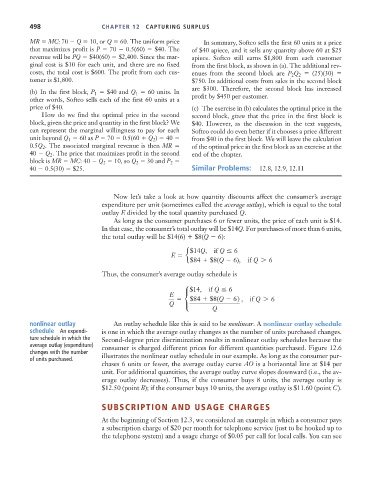Page 524 - Microeconomics, Fourth Edition
P. 524
c12capturingsurplus.qxd 7/22/10 10:41 AM Page 498
498 CHAPTER 12 CAPTURING SURPLUS
MR MC: 70 Q 10, or Q 60. The uniform price In summary, Softco sells the first 60 units at a price
that maximizes profit is P 70 0.5(60) $40. The of $40 apiece, and it sells any quantity above 60 at $25
revenue will be PQ $40(60) $2,400. Since the mar- apiece. Softco still earns $1,800 from each customer
ginal cost is $10 for each unit, and there are no fixed from the first block, as shown in (a). The additional rev-
costs, the total cost is $600. The profit from each cus- enues from the second block are P 2 Q 2 (25)(30)
tomer is $1,800. $750. Its additional costs from sales in the second block
are $300. Therefore, the second block has increased
(b) In the first block, P 1 $40 and Q 1 60 units. In
other words, Softco sells each of the first 60 units at a profit by $450 per customer.
price of $40. (c) The exercise in (b) calculates the optimal price in the
How do we find the optimal price in the second second block, given that the price in the first block is
block, given the price and quantity in the first block? We $40. However, as the discussion in the text suggests,
can represent the marginal willingness to pay for each Softco could do even better if it chooses a price different
unit beyond Q 1 60 as P 70 0.5(60 Q 2 ) 40 from $40 in the first block. We will leave the calculation
0.5Q 2 . The associated marginal revenue is then MR of the optimal price in the first block as an exercise at the
40 Q 2 . The price that maximizes profit in the second end of the chapter.
block is MR MC: 40 Q 2 10, so Q 2 30 and P 2
40 0.5(30) $25. Similar Problems: 12.8, 12.9, 12.11
Now let’s take a look at how quantity discounts affect the consumer’s average
expenditure per unit (sometimes called the average outlay), which is equal to the total
outlay E divided by the total quantity purchased Q.
As long as the consumer purchases 6 or fewer units, the price of each unit is $14.
In that case, the consumer’s total outlay will be $14Q. For purchases of more than 6 units,
the total outlay will be $14(6) $8(Q 6):
$14Q, if Q 6
E e
$84 $8(Q 6), if Q 7 6
Thus, the consumer’s average outlay schedule is
$14, if Q 6
E
• $84 $8(Q 6) , if Q 7 6
Q
Q
nonlinear outlay An outlay schedule like this is said to be nonlinear. A nonlinear outlay schedule
schedule An expendi- is one in which the average outlay changes as the number of units purchased changes.
ture schedule in which the Second-degree price discrimination results in nonlinear outlay schedules because the
average outlay (expenditure) consumer is charged different prices for different quantities purchased. Figure 12.6
changes with the number illustrates the nonlinear outlay schedule in our example. As long as the consumer pur-
of units purchased.
chases 6 units or fewer, the average outlay curve AO is a horizontal line at $14 per
unit. For additional quantities, the average outlay curve slopes downward (i.e., the av-
erage outlay decreases). Thus, if the consumer buys 8 units, the average outlay is
$12.50 (point B); if the consumer buys 10 units, the average outlay is $11.60 (point C).
SUBSCRIPTION AND USAGE CHARGES
At the beginning of Section 12.3, we considered an example in which a consumer pays
a subscription charge of $20 per month for telephone service (just to be hooked up to
the telephone system) and a usage charge of $0.05 per call for local calls. You can see

